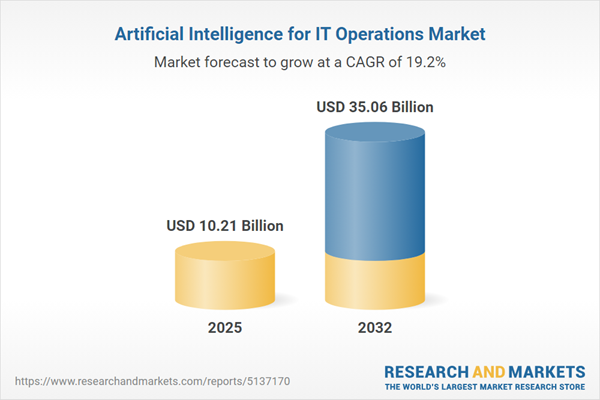Speak directly to the analyst to clarify any post sales queries you may have.
Artificial Intelligence for IT Operations (AIOps) is rapidly redefining enterprise IT management. By automating key processes and optimizing performance, AIOps addresses the demands of today’s distributed, digital-forward environments, empowering organizations to enhance efficiency and provide dependable IT services at scale.
Market Snapshot: Artificial Intelligence for IT Operations Market
The Artificial Intelligence for IT Operations market is gaining significant traction as organizations worldwide intensify digital transformation efforts. As of 2024, the market stands at USD 8.59 billion and is projected to reach USD 10.21 billion by 2025. Looking ahead to 2032, experts anticipate substantial growth with an expected value of USD 35.06 billion, sustained by a compound annual growth rate (CAGR) of 19.21%. This expansion is propelled by increased cloud adoption, modernization through microservices architectures, and heightened demand for real-time data analytics. Enterprises are prioritizing scalable, automation-driven platforms to maintain agile and secure IT operations as complexity grows.
Scope & Segmentation
- Component: Managed Services deliver ongoing monitoring and management for intricate enterprise infrastructures. Professional Services offer guidance to facilitate successful AIOps integration and optimize modernization projects. AIOps Solutions drive automation of event management and fast root cause analysis, supporting reduced mean time to resolution.
- Deployment Mode: Cloud-based AIOps offers operational agility across hybrid, public, and private environments, appealing to businesses seeking easy scalability. On-premise models support enterprises with strict compliance or data sovereignty needs, providing robust control and regulatory assurance.
- Enterprise Size: Large Enterprises depend on AIOps for advanced governance, compliance, and effective risk management in layered IT ecosystems. Small and Medium Enterprises gain value by streamlining IT processes cost-effectively and improving resource allocation to meet evolving business needs.
- End User: Government and Defense sectors adopt AIOps to support secure, standards-compliant operations. Healthcare and Life Sciences integrate advanced data controls, ensuring privacy and regulatory compliance in managing sensitive patient information. IT and Telecom leaders use automation to improve network performance and consistency. Manufacturing focuses AIOps on streamlining production workflows, while Retail emphasizes speed and agility to adapt systems in dynamic markets.
- Regional Segmentation: The Americas benefit from longstanding technology adoption and ecosystem partnerships. Europe emphasizes compliance-driven IT modernization across multiple industries. In the Middle East and Africa, providers tailor offerings to unique regulatory and business needs. Asia-Pacific’s rapid digital expansion is powered by strong policy support and significant market engagement.
- Key Market Participants: Leading vendors such as International Business Machines Corporation, Broadcom Inc., Microsoft Corporation, Splunk Inc., ServiceNow, Inc., Cisco Systems, Inc., BMC Software, Inc., Dynatrace LLC, Datadog, Inc., and HCL Technologies Limited shape the landscape with innovations that support enterprise transformation and IT operational maturity.
Artificial Intelligence for IT Operations Market: Key Takeaways for Decision-Makers
- AI-enabled automation accelerates incident management and boosts adaptability, empowering organizations to pursue strategic modernization initiatives efficiently.
- Unified platforms, integrating comprehensive APIs, streamline IT oversight and contribute to consistent, high-performing networks across complex, distributed infrastructures.
- Rich telemetry data enhances proactive anomaly detection and strengthens real-time governance, supporting early threat mitigation and robust system reliability.
- Cloud-native and modular solutions help organizations address regulatory flexibility, particularly benefiting sectors with specific compliance mandates such as finance and healthcare.
- Improvements in explainable AI promote transparency, aligning recommendations and automated actions with broader business strategies for increased executive confidence.
- Edge computing support enhances centralized analytics, maintaining regulatory alignment and consistency for organizations with globally dispersed operations.
Tariff Impact: Navigating Regulatory Shifts
Anticipated U.S. tariff changes in 2025 are prompting enterprises to rely increasingly on software-driven procurement models. In response to projected hardware price increases, organizations are diversifying vendor relationships and utilizing flexible contracting to maintain competitive IT operations. These shifts enable greater agility, allowing companies to adapt quickly to regulatory developments and optimize resource deployment.
Methodology & Data Sources
This analysis is grounded in systematic public research, regulatory reviews, and expert input from executive interviews and vendor panels. Proprietary B2B survey findings supplement these perspectives, aligning conclusions with the current priorities of senior IT leadership.
Why This Report Matters
- Equips leaders to create AIOps strategies supporting both resilience and compliance in increasingly complex hybrid IT environments.
- Enables informed procurement and risk mitigation, empowering organizations to maintain agility amidst evolving market and regulatory landscapes.
- Guides targeted technology investment and strategic supplier partnerships, advancing digital capability and operational excellence.
Conclusion
C-level executives can leverage this report to optimize IT strategies, strengthen governance, and drive successful AIOps deployment for long-term adaptability and operational progress.
Additional Product Information:
- Purchase of this report includes 1 year online access with quarterly updates.
- This report can be updated on request. Please contact our Customer Experience team using the Ask a Question widget on our website.
Table of Contents
3. Executive Summary
4. Market Overview
7. Cumulative Impact of Artificial Intelligence 2025
Companies Mentioned
The companies profiled in this Artificial Intelligence for IT Operations market report include:- International Business Machines Corporation
- Broadcom Inc.
- Microsoft Corporation
- Splunk Inc.
- ServiceNow, Inc.
- Cisco Systems, Inc.
- BMC Software, Inc.
- Dynatrace LLC
- Datadog, Inc.
- HCL Technologies Limited
Table Information
| Report Attribute | Details |
|---|---|
| No. of Pages | 184 |
| Published | October 2025 |
| Forecast Period | 2025 - 2032 |
| Estimated Market Value ( USD | $ 10.21 Billion |
| Forecasted Market Value ( USD | $ 35.06 Billion |
| Compound Annual Growth Rate | 19.2% |
| Regions Covered | Global |
| No. of Companies Mentioned | 11 |









